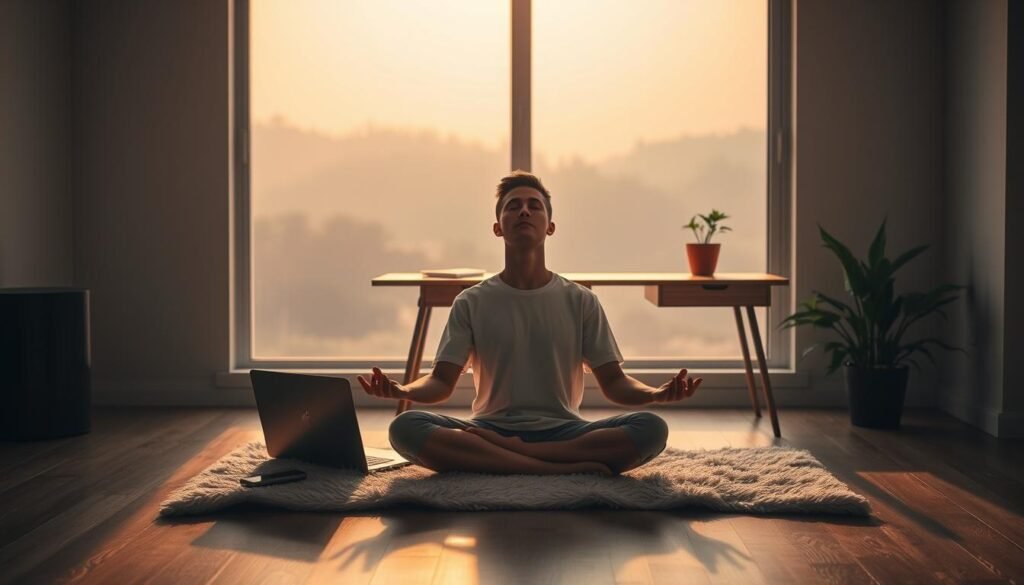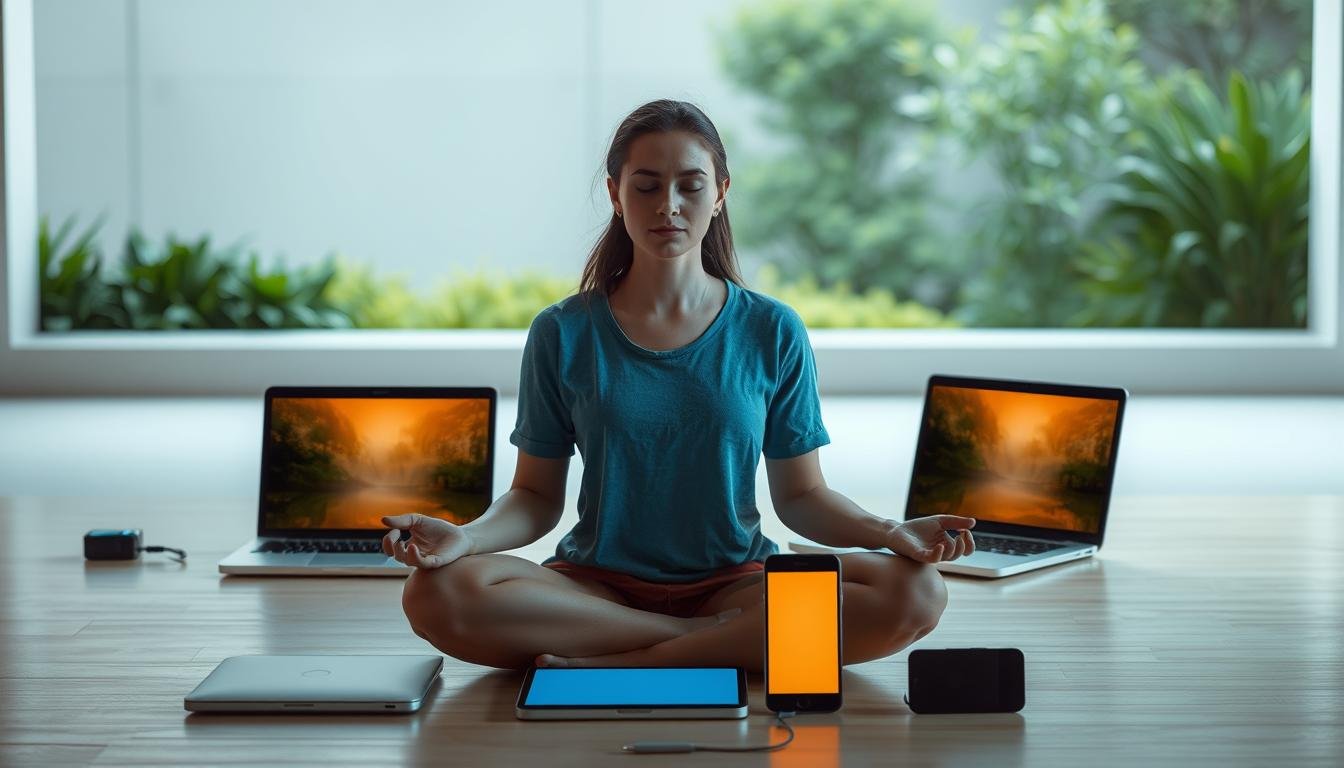Mindfulness Meets Technology: Achieving Harmony
We’re surrounded by screens, notifications, and endless digital tasks. It’s no wonder many of us feel stretched thin. But what if your devices could enhance your well-being instead of draining it? The answer lies in blending intentional habits with modern tools.
Imagine a world where your phone helps you pause, refocus, and reconnect with what matters. This isn’t a fantasy—it’s the heart of mindful technology. By rethinking how we interact with devices, we can create a healthier relationship with the digital world.
This guide walks you through simple, actionable steps to align your tech use with your personal values. You’ll learn to set boundaries, prioritize meaningful connections, and avoid the trap of constant distraction. Small changes, like scheduling screen-free time or using apps that encourage breaks, add up quickly.
The goal isn’t to abandon innovation but to harness it thoughtfully. When used with purpose, digital tools can support productivity and inner calm. Let’s explore how to design a daily routine that works for you—not against you.
Key Takeaways
- Modern devices often contribute to stress but can be repurposed for wellness.
- Intentional habits transform tech from a distraction to a support system.
- Boundaries like screen-free time protect mental clarity.
- Apps designed for focus or relaxation amplify mindful practices.
- Balance comes from aligning tech use with personal priorities.
Introduction to Mindful Technology and Its Impact on Well-Being
Digital devices shape our daily routines in ways we often don’t notice. Studies reveal that stepping back from screens boosts productivity by 23% and improves sleep quality. Yet many apps keep us hooked through clever tricks—like flashing red alerts or content that vanishes if we don’t check fast enough.

Mindful vs. Mindless Habits
Not all screen time is equal. Scrolling without purpose drains energy, while intentional engagement preserves mental clarity. Here’s how they compare:
| Feature | Mindful Use | Mindless Use |
|---|---|---|
| Notifications | Turned off during meals | Constant interruptions |
| Scrolling Habits | 20-minute daily limit | Hours lost weekly |
| Device Proximity | Charged outside bedroom | Nightly sleep disruptions |
The Cost of Digital Chaos
Smartphones within arm’s reach reduce problem-solving skills by 15%, according to University of Chicago research. Endless feeds trigger stress hormones, making it harder to enjoy real-world moments. Setting boundaries isn’t about rejecting innovation—it’s about reclaiming focus.
Small shifts create big wins. Try silencing non-essential alerts for three hours daily. Notice how your mind feels lighter. That’s harmony in action.
Understanding the Essence of Mindfulness Technology
Digital habits form silently, weaving into the fabric of our days without deliberate intent. This is where mindful technology steps in—a practice that turns device use from reactive to purposeful. It’s not about deleting apps or swearing off screens, but rather reshaping how we engage with them.

Defining Key Concepts
At its core, this approach rests on three pillars. Intentionality means asking, “Does checking my phone right now serve me?” before unlocking it. It’s choosing video calls over endless emails when nurturing relationships matters most.
Awareness involves noticing how certain apps make your shoulders tense or your breath quicken. Like realizing TikTok sessions leave you drained, while podcast walks boost creativity. These observations guide smarter choices.
Reflection turns occasional pauses into lasting change. Try a weekly check-in: Did your screen time align with personal goals? Did doomscrolling replace that book you meant to read? Small adjustments here create lasting shifts.
By embracing these principles, devices become tools for growth rather than sources of distraction. It’s about making tech work for you, not the other way around.
Practical Techniques for Mindful Technology Use
Creating balance with devices starts with simple, intentional choices. Small adjustments to daily habits can transform how your phone or tablet impacts your energy and focus. Let’s explore strategies that put tools like screen-time trackers and app blockers to work for you.
Tips for Setting Digital Boundaries
Your phone’s built-in features make boundary-setting easier. iOS Screen Time, for example, offers:
| Feature | How It Helps |
|---|---|
| Activity Data | Shows app usage patterns & pickup frequency |
| App Limits | Blocks distracting apps after set time |
| Downtime | Hides non-essential apps during focus hours |
Try charging devices outside bedrooms to avoid late-night scrolling. Blue light from screens tricks your brain into daytime mode, disrupting sleep. Physical distance creates mental clarity.
Utilizing Mindfulness and Meditation Apps
Certain apps actually support healthier habits. Headspace offers 3-minute breathing exercises between meetings. Calm’s sleep stories replace endless TikTok sessions. Forest grows virtual trees when you resist checking notifications.
These tools turn idle moments into opportunities for reflection. A daily 10-minute practice with guided sessions builds awareness over time. Pair them with Do Not Disturb mode during meals or family time for full effect.
Benefits of Mindful Technology in Daily Life
Your phone buzzes, but you don’t reach for it—because you’ve trained yourself to prioritize. This simple shift unlocks surprising benefits that ripple through work and personal time. Intentional digital habits help reclaim hours once lost to endless scrolling.

Enhancing Focus and Productivity
Constant pings fracture attention spans. By silencing non-essential alerts, you create space for deep work. One study found workers gain 42 more productive minutes daily when limiting notifications.
Consider these comparisons:
| Features | Scattered Use | Intentional Use |
|---|---|---|
| Email Checks | 32/day average | 3 scheduled blocks |
| Task Switching | Every 40 seconds | 90-minute focus sessions |
| Creative Output | Fragmented ideas | Completed projects |
Work-life balance improves when devices stop dictating schedules. Try setting “digital sunset” hours where screens dim after dinner. Your brain gets needed downtime, making mornings more energized.
These practices strengthen your ability to choose where attention goes. Over time, you’ll notice clearer thinking and better connections in all areas of life. That’s how small changes create lasting impact.
Overcoming Digital Distractions and Managing Stress
Ever feel like your phone is shouting for attention every few minutes? You’re not alone. Research shows 53% of university students face moderate-to-severe stress from constant digital demands. The culprit? Clever app designs that exploit our natural responses.

Breaking Free From Alert Addiction
Red notification badges aren’t accidental. Designers use this color because it triggers urgency—like a flashing warning light. One study found people check phones 150 times daily just to clear these alerts. Your brain stays in high-alert mode, draining mental energy.
Start by auditing your lock screen. Ask: “Does this alert improve my life?” Keep only:
- Messages from close family
- Calendar reminders
- True emergency apps
Social platforms thrive on FOMO (fear of missing out). Try weekend detoxes with friends—no scrolling, just real conversations. You’ll notice how artificial “likes” feel compared to genuine laughter.
| Essential Alerts | Distraction Traps |
|---|---|
| Texts from spouse | Social media likes |
| Medication reminders | Promotional emails |
| Severe weather warnings | Game app notifications |
Create physical spaces where devices aren’t allowed—like dinner tables or bathrooms. This gives your nervous system regular breaks from digital demands. Your mental health will thank you.
For stubborn habits, try grayscale mode. Without colorful icons, apps lose their magnetic pull. Small changes create big shifts in how you use your phone—putting you back in control.
Leveraging “mindfulness technology” for a Balanced Life
Finding calm in a connected world starts with smart tool choices. Digital mindfulness blends age-old relaxation methods with modern resources, offering stress relief at your fingertips. Research shows 15-minute daily sessions with guided audio programs can lower anxiety by 34% in eight weeks.
- Offer sessions under 10 minutes for busy schedules
- Track progress without addictive streaks
- Provide science-backed breathing techniques
Compare popular options:
| Feature | Wellness-First Apps | Standard Apps |
|---|---|---|
| Session Length | 3-15 minutes | 30+ minutes |
| Notifications | Gentle reminders | Constant prompts |
| Data Use | Private progress tracking | Social sharing focus |
Schedule tech-assisted pauses during natural breaks—after meetings or before lunch. Pair this with device-free evenings to let insights settle. Over time, you’ll notice better emotional regulation during tough conversations or deadlines.
True balance comes from using tools when they serve you—then stepping away to enjoy unplugged moments. Your mental health thrives when screens support rather than steer your day.
Mindful Technology in Educational and Professional Settings
Classrooms and boardrooms face growing pressure to balance connectivity with cognitive well-being. Schools and companies now explore ways to harness digital tools without sacrificing focus or emotional stability. Let’s examine strategies that benefit both learners and professionals.
Improving Academic Performance and Mental Health
University life often amplifies stress, with 52% of students reporting anxiety that impacts grades. App-based programs like Calm Campus show promise—participants saw 28% lower stress levels in 6 weeks. These tools teach breathing techniques during study breaks, replacing endless scrolling with quick resets.
Establishing Healthy Digital Habits at Work
Forward-thinking companies now set “quiet hours” where messaging platforms pause. Employees report 37% fewer interruptions during deep work phases. Teams using focus apps like Freedom complete projects 19% faster while maintaining better work-life separation.
| Strategy | Educational Setting | Professional Setting |
|---|---|---|
| Scheduled Tech Breaks | 5-minute meditation between classes | No emails after 7 PM |
| App Usage | Guided study timers | Meeting-free focus blocks |
| Support Systems | Peer accountability groups | Manager-led digital detox challenges |
Both environments thrive when institutions model balanced tech use. A Michigan high school saw attendance rise 12% after introducing phone-free lunch zones. Similarly, accounting firms using focus-first policies report 41% higher client satisfaction scores.
Exploring Advanced Tools and Innovations in Digital Mindfulness
Innovative platforms now adapt to your habits, nudging you toward healthier routines without overwhelming alerts. Cutting-edge apps analyze screen time patterns to suggest personalized breaks—like a 90-second stretch after an hour of scrolling. These tools go beyond basic timers, using biometric feedback to adjust recommendations based on your stress levels or focus capacity.
How Data Shapes Smarter Choices
Developers now prioritize features that respect your attention. One app pauses social media during family dinners, while another dims work emails after sunset. By tracking usage trends, these systems identify when you’re most vulnerable to distraction—then offer guided breathing exercises instead.
Future updates might predict burnout risks by combining calendar data with heart rate variability. Imagine a fitness tracker that suggests meditation content before high-pressure meetings. This shift from reactive alerts to proactive support redefines how we engage with technology.
The next wave of apps focuses on subtle, sustainable changes. Instead of rigid limits, they offer flexible boundaries that grow with your goals. As these data-driven solutions evolve, they’ll help millions craft digital experiences that truly align with their values—one mindful tap at a time.
FAQ
How can I use devices without feeling overwhelmed?
Start by setting clear limits, like turning off non-urgent alerts or scheduling screen-free time. Apps like Insight Timer offer reminders to pause and breathe, helping you stay grounded.
What’s the difference between intentional and passive screen time?
Intentional use involves purpose, like video calls with loved ones or learning new skills. Passive scrolling, like endless feeds, often lacks focus. Tools like Forest encourage active engagement by rewarding you for staying on task.
Can apps really improve mental clarity?
Yes! Platforms like Calm and Headspace provide guided sessions to reduce stress. Pairing these with shorter, focused work intervals (try the Pomodoro Technique) can boost concentration.
How do I handle constant notifications at work?
Customize “Do Not Disturb” modes for deep work hours. Tools like Freedom block distracting sites, while wearable devices like the Apple Watch can nudge you to stretch or hydrate.
Are there tools to help kids focus during study time?
Apps like Focus@Will use music tailored to improve attention. Schools also use platforms like ClassDojo to teach healthy habits, such as taking mindful breaks between assignments.
What role does data play in improving digital habits?
Features like screen-time reports on iOS or Digital Wellbeing on Android highlight usage patterns. Reviewing this weekly helps identify areas to adjust, like reducing late-night scrolling.
How can teams adopt healthier digital practices?
Encourage “no-meeting” blocks or use collaboration tools like Slack with status updates to respect focus time. Shared calendars can also promote balanced workflows and reduce burnout.
Share this content:




Post Comment